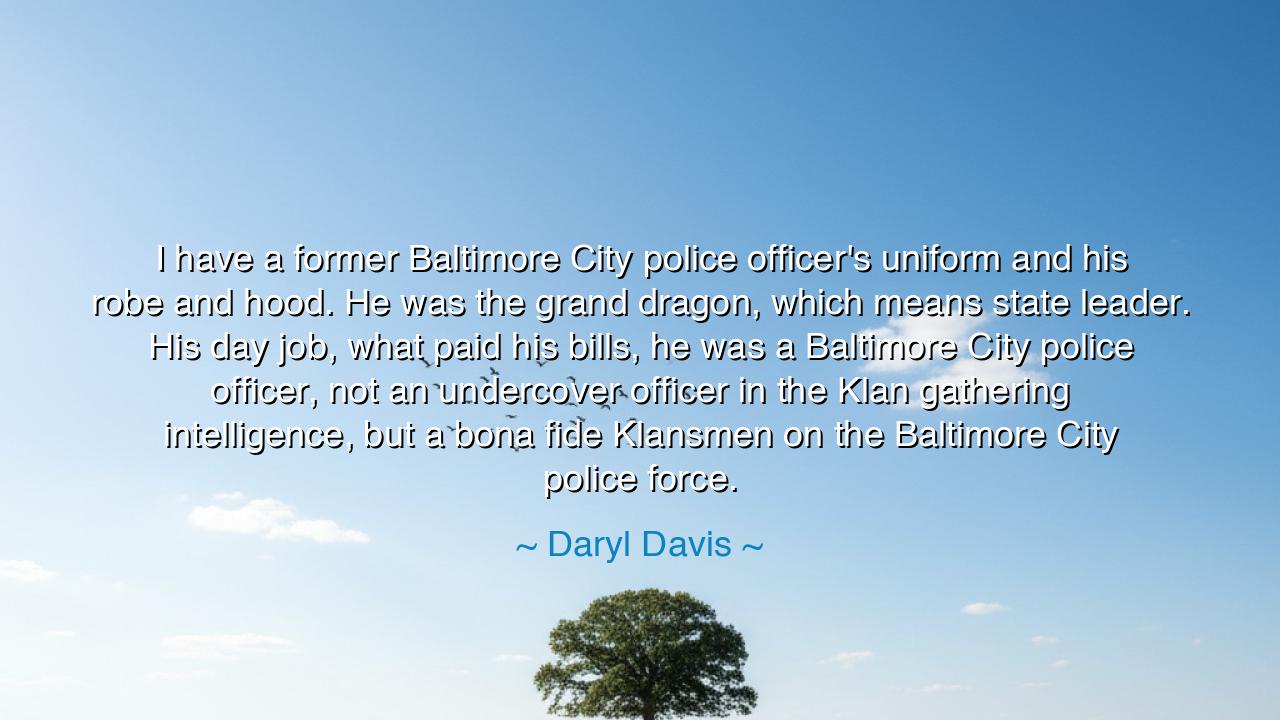
I have a former Baltimore City police officer's uniform and his
I have a former Baltimore City police officer's uniform and his robe and hood. He was the grand dragon, which means state leader. His day job, what paid his bills, he was a Baltimore City police officer, not an undercover officer in the Klan gathering intelligence, but a bona fide Klansmen on the Baltimore City police force.






In the stark and haunting words of Daryl Davis, musician, activist, and seeker of truth, we find a revelation that strikes at the very soul of society: “I have a former Baltimore City police officer’s uniform and his robe and hood. He was the grand dragon, which means state leader. His day job, what paid his bills, he was a Baltimore City police officer, not an undercover officer in the Klan gathering intelligence, but a bona fide Klansman on the Baltimore City police force.” This is not a statement of bitterness, but of confrontation with a chilling truth — that evil can wear the mask of authority, and that prejudice can dwell within the very institutions meant to protect. Davis does not speak as an accuser alone, but as a witness, a man who has seen hatred unmasked and transformed by the power of understanding.
The origin of this quote arises from Daryl Davis’s extraordinary life mission: to confront members of the Ku Klux Klan not with violence or condemnation, but with dialogue. A Black man sitting down with white supremacists, he sought not to humiliate them, but to understand them — to see the human being beneath the hood. Through conversation, patience, and courage, Davis persuaded over two hundred Klansmen to renounce their hatred and give up their robes, symbols of terror and division. The uniform and robe he speaks of are trophies of peace, not conquest — reminders that ignorance can be disarmed not only by protest, but by compassion armed with truth.
When Davis tells us that a police officer — a sworn guardian of justice — was also a grand dragon of the Klan, he reveals the terrible duality that has haunted civilizations throughout time: the corruption of power by prejudice. In the ancient world, too, kings and priests often cloaked cruelty in sacred or lawful garments, believing their titles sanctified their deeds. The lesson Davis exposes is eternal — that justice must be rooted in conscience, not costume. The robe of hate and the uniform of law, when worn by one man, become an abomination; they symbolize not two identities, but a single betrayal — the betrayal of humanity itself.
Yet, Davis does not merely point to the darkness — he lights a torch within it. He does not hate the man who once wore both symbols; instead, he keeps those relics as testaments of redemption. He shows us that transformation is possible even for those buried in hatred, if only someone dares to reach across the chasm. His actions embody a higher courage — not the courage of battle, but the courage to see one’s enemy as human. In this, he walks the path of the ancients: like Socrates, who confronted ignorance through dialogue, or like Mahatma Gandhi and Martin Luther King Jr., who met oppression with peace and understanding, knowing that to fight hate with hate only multiplies its power.
The symbolism of the robe and uniform is profound. The robe represents ideological blindness, the belief in division and supremacy; the uniform represents institutional power, the authority of the state. When these two garments coexist upon one man, they form a warning to all generations — that power without empathy is tyranny, and that justice without self-examination becomes hypocrisy. Davis’s possession of these artifacts is therefore not macabre, but sacred: they are relics of humanity’s potential both for corruption and for change. In his home, they serve not as trophies of conquest, but as reminders of what it means to overcome the deepest shadows of the human heart.
The lesson Davis offers is both simple and demanding: if one wishes to end hatred, one must first face it without fear. Evil thrives in silence and separation; it weakens in the presence of understanding. This does not mean to excuse it, but to confront it as a sickness of the spirit, not an unchangeable fate. Davis’s example teaches that dialogue is a weapon as sharp as any sword, and that transformation often begins not with accusation, but with conversation. When we engage even our enemies with the courage to listen, we plant the first seeds of peace — and sometimes, those seeds grow where none expected them to.
So, my child of justice and understanding, take heed of Daryl Davis’s wisdom. The world will always contain robes and uniforms — symbols of belief and power — but what matters most is the soul that wears them. If you would see the world healed, learn not only to resist hatred, but to transform it. Seek out ignorance and meet it with knowledge; seek out fear and meet it with courage; seek out hatred and meet it with love tempered by truth. For it is not by shaming others that we end darkness, but by holding up a mirror that shows them their own humanity — the same humanity that, when awakened, casts off both robe and uniform to stand free at last.






AAdministratorAdministrator
Welcome, honored guests. Please leave a comment, we will respond soon